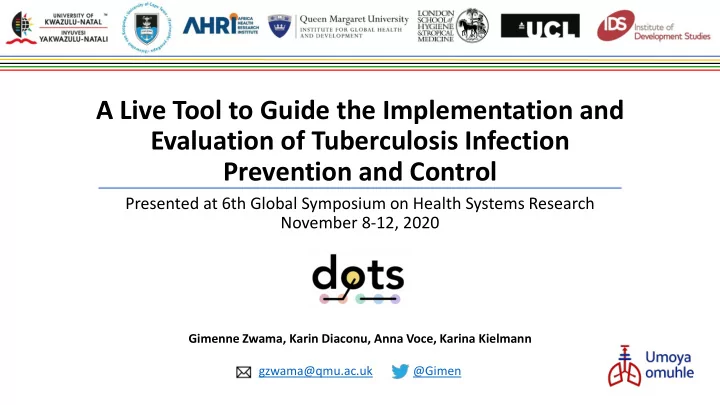

A Live Tool to Guide the Implementation and Evaluation of Tuberculosis Infection Prevention and Control Presented at 6th Global Symposium on Health Systems Research November 8-12, 2020 Gimenne Zwama, Karin Diaconu, Anna Voce, Karina Kielmann gzwama@qmu.ac.uk @Gimen
Background • For our multi-disciplinary project, we did a scoping review of the literature reporting whole system influences on the implementation of tuberculosis infection prevention and control measures (TB-IPC) at health facility level in low- and middle-income countries. • This was a very insightful exercise to identify gaps in knowledge as well as potential barriers and opportunities for TB-IPC implementation. • Though incredibly valuable, we soon realised that it is labour-intensive to unpack and map the complexity of and dynamics between all that can be influencing the implementation of TB-IPC at facility level. • This challenge is not unique to TB-IPC implementation. • For the successful implementation of solutions and tackling of problems that affect the health and well-being of people globally, we need to join forces and connect explicit and tacit knowledge held across system actors, disciplines and sectors.
Methods Include input based on research and experiences of individual system actors dots. Collect, connect and categorise past and present is a collaborative, knowledge in an ongoing manner independent platform that facilitates the implementation Map complexity through interactive visuals in of solutions by connecting the accessible language (expand and hide details) dots between different types of knowledge from Apply filters to complexity maps, e.g. stakeholders across the knowledge source, location, system level system. Search and summarise knowledge areas of specific interest
Outcomes
Discussion However, to be able to connect the dots we need: • You! • Whether you are a policy maker, researcher, practitioner, businessperson or part of a donor, philanthropic or non-governmental organisation. We would love to hear your thoughts. • What is good about dots. and what is missing? • What do you expect to be the challenges? • How would you use dots. ? • Artificial intelligence and big data ethics support in developing the platform. • Information and user experience designers to translate data into appealing, user-friendly complexity maps. Get in touch and let’s connect!
Recommend
More recommend